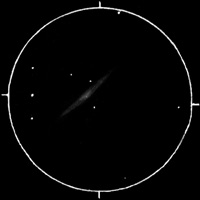Deep Sky
Without any doubt, the 'coolest' way (for the non-faint-fuzzy-gazing world), to observe Deep Sky Objects is to
photograph them. But it's also the hardest, and requires some investments. But there are ways you can
get some nice results without actually bankrupting yourself.
Photographing constellations with a standard 50mm lens from an ordinary tri-pod will give you nice images, even
when exposures are limited to a few tens of seconds. Barn-door mounts permit longer exposures, even with
telephoto-lenzes. And piggy-back mounted on a parallactic mounted telescope you can go on forever. If you are really
lucky you might even be able to use a telescope in a public or private observatory.
Another way to enjoy deep sky is to embark on a project, or several if you're a greedy observer.
Projects may be very long term embarkments but might also be one night stands. A lot of projects
consist of observing a given list of objects, in most often an unlimited amount of time. The
most famous of these lists is the Messier list (originally conceived of a catalogue of fuzzy things that
don't move and thus aren't comets). More recently others were conceived such as the
Caldwell list and the Herschel 400.
Ofcourse you are not limited to given lists. Anything will do: you wanna observe any galaxy in
Pegasus above magnitude 15? You got yourself a project.
Another project might be to conceive your own little atlas of the sky. Who doesn't want to have
his own photographic NGC-album, or all known galactic open clusters drawn using nothing larger then a 7x50
binocular? You might want to start with something easier though. Nice projects for starting amateurs
are 'A Photographic Atlas of the Constellations' or your own 'Messier Album'.
You might wonder what's the point of drawing an object when photography has advanced so much in the past
few years. First of all, I can't afford an expensive CCD or DSLR, or even a decent tracking mount. But more
importantly, drawings teaches you to look at an object. Instead of moving from one object to another without
seeing all there is to see, you have to look at it for at least 10 minutes to draw it. In those 10 minutes
many subtleties that would have eluded you otherwise will pop out. And finally, you get something back from
all those cold nights to look at when it's clouded.
|









